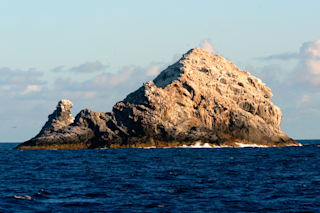This article appeared in the January/February 2022 issue of Discover magazine as "The Tip of the Volcano." Become a subscriber for unlimited access to our archive.
About 600 miles northwest of Honolulu, in the middle of the Pacific Ocean, two small pinnacles poke out of the sea. To an observer, the 5 acres of rock known as Pūhāhonu might seem insignificant, except as a landing pad for weary seabirds. But their presence suggests the existence of something much bigger beneath the surface: what many experts are now calling the largest single volcano on Earth.
The volcano's exposed tip is about a sixth of the Eiffel Tower's height. (Credit: Maxx-Studio/Shutterstock)
Maxx-Studio/Shutterstock
New seafloor mapping of the Papahānaumokuākea Marine National Monument revealed Pūhāhonu’s full size. Michael Garcia, a volcanologist at University of Hawai’i at Mānoa, and his colleagues found that the mostly submerged volcano contains at least 35 cubic miles of rock, ...















